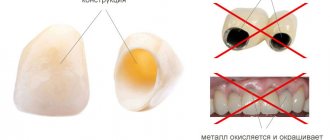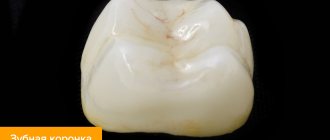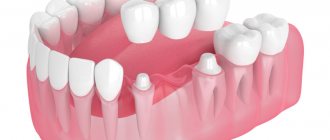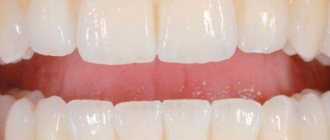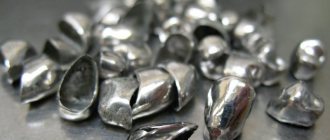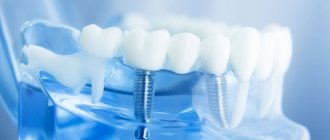Installation of crowns on the front teeth from modern materials, with the participation of professional orthopedists and at a reasonable price.
The process of restoring teeth in the frontal zone is one of the most complex and costly, since the doctor faces an important task - to obtain not only excellent functional characteristics, but also to achieve impeccable aesthetics. In this case, the crowns on the front teeth must fully correspond in shade, shape and transparency to their natural counterparts.
Today, the dental market offers several materials suitable for restoring the characteristics of anterior teeth, but despite their diversity, the number of dissatisfied patients does not decrease. This is due, first of all, to the insufficient level of professionalism of specialists, as well as the wrong choice of crown option.
In this article we will provide detailed information about the existing types of prostheses. We will tell you about their main advantages and disadvantages, and also present the prices established in modern clinics. You will learn about these and other points below.
Crowns on the front teeth: current types of treatment
Modern people have received a number of new opportunities in the field of dental treatment. Firstly, pain during treatment procedures has decreased. Secondly, today it is possible to restore the integrity of even a row in which dental units are completely missing. At the same time, artificial analogues will naturally reproduce the aesthetic and functional characteristics of natural teeth.
Thirdly, positive changes have also affected the field of prosthetics. If previously patients only had metal crowns installed, which did not have good aesthetics and were quickly subjected to oxidative processes, now the situation has changed dramatically. Currently, it is possible to fix crowns on the front teeth, which, according to reviews, are not inferior to their natural counterparts in their shade, translucency and strength. At the same time, each patient has the opportunity to choose suitable prosthetic options
We'll talk about this in more detail later.
What are the best crowns for front teeth?
Today, dental clinics use several options for orthopedic structures for front teeth: metal-ceramic prostheses, zirconium crowns, solid ceramic products and improved E-MAX models.
Many visitors to modern dentistry are interested in: “Which crowns are best to fix on the upper front teeth?” In this case, the preferred option would be to install all-ceramic structures. For the manufacture of prostheses of the above type, porcelain material is used, obtained by injection molding or by layer-by-layer application. Alternative designs also include ceramic prostheses on a zirconium base.
Prosthetics on implants
Implantation is a modern way to restore teeth. The operation consists of installing titanium pins on which removable or fixed dentures are placed. Implantation can be one- or two-stage.
With a one-stage operation, immediate loading of the implant and installation of artificial teeth is possible. Chewing function and aesthetics are restored immediately.
A two-stage installation requires a recovery period between the installation of the implant and the prosthesis. Complete restoration of chewing function and aesthetics is possible only after the implantation of the structure.
Also, prosthetics on implants can be removable or non-removable.
For removable prosthetics, a two-stage method is used. Abutments are installed only after osseointegration and are selected depending on the type of fastening, which can be locking or beam.
Installing permanent structure on an implant allows you to restore one or more teeth. The implementation of the design can be one-step or stage-by-stage. The non-removable method allows you to install a prosthesis without grinding or any damage to adjacent teeth.
Attending doctors at the Elident clinic
Mlodik Boris Naumovich
Dental surgeon, implantologist, orthopedist
Clinical experience : 26 years
Vakhrushev Alexander Viktorovich
Dental surgeon, implantologist, orthopedist
Clinical experience : 25 years
Metal-ceramic crowns for front teeth
The basis for this design is a metal base with a thickness of 0.5 millimeters. To obtain the material for such prostheses, a combination of chromium and cobalt is used, but sometimes you can find products made from precious alloys. In laboratory conditions, to create such crowns, they resort to the method of layer-by-layer application of ceramic material onto a metal frame. To ensure maximum strength and solidity of the structure, the ceramic mass is fired under high temperature conditions.
An aesthetic disadvantage of the above orthopedic products is the presence of a metal base under the ceramic layer. Moreover, the porcelain material used must be opaque to eliminate the possibility of it showing through the metal.
However, the light transmittance of dentin and enamel should be taken into account, which makes the outermost part of the tooth transparent in bright light. This indicates the inadmissibility of installing metal-ceramic structures for people with increased enamel transparency. The best option for using such crowns would be for patients with low levels of transparency. But it must be borne in mind that in strong lighting, differences in shade and light transmission may still be visible.
So, crowns for the front teeth made of metal-ceramics, as evidenced by reviews, have the following positive characteristics:
- Acceptable aesthetic indicators;
- Affordable price;
- High structural strength.
The disadvantages of such structures include:
- Negative effects on natural teeth;
- The likelihood of allergic reactions to metal material;
- Risk of cyanosis near the gingival margin.
Metal-ceramic crown »
Ceramic crowns for front teeth
These metal-free crowns for the front teeth are considered indispensable when restoring teeth in the frontal area. They allow you to eliminate some of the aesthetic shortcomings of natural enamel, which include excessive abrasion, developmental pathologies and massive surface damage. In addition, all-ceramic designs are ideal for individuals with a high likelihood of allergic reactions to metal alloys. However, they are not installed in the area of chewing teeth, due to their increased fragility.
The ideal option is to fix such crowns within 1-2 lost units. Bridge crowns made of this material are not installed on the front teeth.
However, today, due to the active use of innovative technologies, you can find dentures made of ultra-strong ceramic material, suitable for recreating any lost tooth. Unfortunately, the cost of such a design will exceed the prices for classic products made from solid ceramics.
So, the “advantages” of the products presented above include:
- Impeccable aesthetic indicators;
- Full compatibility with the human body;
- Absolute identity with natural analogues.
Among the disadvantages of metal-free structures are:
- Insufficient strength;
- Overpriced.
Ceramic crowns for teeth »
Zirconium crowns for front teeth
Zirconium crowns for the front teeth are among the most durable and aesthetically perfect modern designs. Due to the use of zirconium material in their manufacture, it is possible to achieve high reliability indicators characteristic of metal and obtain prostheses with good hypoallergenic qualities.
Ceramic crowns for the front teeth, made on the basis of this material, do not have a metal base, which provides excellent aesthetic parameters. But their main advantage is still increased strength.
It should be noted that, despite the positive characteristics presented, some patients express dissatisfaction with the installed zirconium crowns. This is due, first of all, to the rather low light transmittance. That is, the difference between the transparency of natural enamel and the prosthesis material can also be traced here.
This means that it is better to install these designs in patients with slight transparency of natural enamel, which will provide a completely harmonious aesthetic effect.
However, at the present stage of development of dentistry, there is an improvement in the properties of zirconium crowns. Many manufacturers have taken a course towards creating blocks with higher levels of transparency and pre-painted products with a gradient. This made it possible to develop orthopedic structures that are completely identical to natural teeth.
Thus, zirconium dioxide prostheses are famous for the following advantages:
- Acceptable aesthetics;
- Increased reliability indicators.
The disadvantages of such products include:
- Lack of transparency corresponding to natural enamel;
- Zirconium crowns for front teeth are overpriced.
Zirconium crowns »
Ceramics on a zirconium frame
If you are interested in the question: “Which crowns are best to put on the upper front teeth?”, this option is certainly a winner. Such prostheses are ideal for those patients who dream of ultra-strong structures with excellent aesthetic parameters.
Unlike metal-ceramic prostheses with low aesthetic properties, zirconium-based crowns combine high aesthetic properties and the necessary strength.
Such crowns for the front teeth made of zirconium, as confirmed by reviews, are used not only in the process of single prosthetics, but are also excellent for the manufacture of bridge structures. At the same time, increased strength is achieved through the use of computerized technologies and milling methods.
So, some of the positive aspects when using these products include:
- Ideal aesthetics;
- Excellent reliability indicators.
Negative sides:
- Overcharge.
Which denture is best for missing teeth?
Previously, patients who, for one reason or another, were unable to have implants installed, had to put up with rather uncomfortable prostheses made of hard plastic. Today there are modern designs on the market that cause virtually no inconvenience to their owner. Many are also looking for the best removable dentures for the upper jaw, since it is when restoring teeth in the upper jaw that good fixation of the structure is especially important so that the denture does not fall out in the most unexpected cases. Installation of a high-quality fixed (conditionally removable) complete denture is not complete without implantation.
Bridge prosthesis on implants
When several teeth are missing in a row, implant-supported dentures are the ideal choice. As a rule, 2 implants are installed, onto which a prosthesis imitating the crown part of the tooth is subsequently fixed.
Classic bridges
Fixed structures that replace a fragment of the dentition and are installed on adjacent ground teeth. The most modern bridges are usually made of ceramic and look more aesthetically pleasing than their metal counterparts.
Butterfly prosthesis
So named because of its shape, which resembles the wings of insects. Allows you to replace up to three missing teeth in a row. A plastic butterfly prosthesis imitates the crown of a tooth and part of the gum, attached to adjacent teeth using clasps. Application is justified as a temporary measure.
Clasp dentures
The best dentures of this type are considered to be structures made of nylon and acrylic, imitating part of the dentition on both sides of the jaw. There are designs with metal arches and with metal fixing elements (clasps), the disadvantages of which are allergic reactions, injury to one’s own supporting teeth and aesthetics.
Complete denture on implants with bar fixation
It is considered one of the best options for a complete denture on implants, since the load is distributed evenly across the entire beam and high stability of the entire structure is achieved.
Complete denture on implants with ball-shaped fixation
A spherical abutment is installed on each implant, which is fixed to the prosthesis using special locks. It is also considered an excellent option, but is slightly inferior to beam structures in terms of reliability.
Removable denture on mini-implants
Mini-implants are also installed into the bone, so the volume of bone tissue is just as important here as when installing standard implants. In this case, only removable structures are suitable for prosthetics, since mini-implants are used as a temporary option and cannot bear a more serious, permanent load.
Complete removable plate denture
Removable complete dentures completely model the jaw and palate. Today there are many models on the market, but the latest generation of acrylic and nylon prostheses are considered the most modern.
Free consultation
Our specialists will conduct a free consultation and select the best treatment option for you.
Sign up now! Online registration
+7 (495) 649-41-19
e.max crowns on front teeth
When considering crowns for the front teeth, we strive to give a clear answer as to which ones are better aesthetically and functionally. The undisputed leader in this direction is Emax glass ceramics. This is an improved modern material, the creation of which is based on the use of lithium disilicate, which has impeccable characteristics. Emax ceramic crowns look perfect on the front teeth because they have light transmission that fully matches natural enamel. The same can be said about veneers made from the above material; they are completely indistinguishable from natural teeth
Today there are 2 known options for Emax materials:
- E.maxPRESS. Widely used to obtain dentures and veneers. This involves the injection molding method under the influence of pressure and high temperature conditions. Such crowns are indispensable when restoring single teeth or creating short bridge structures.
- E.maxCAD. In the production of this material, modern computer technologies and computer-controlled machines are used. Such crowns are characterized by less high reliability, which eliminates the possibility of creating bridge structures and ultra-thin veneers. Also among the disadvantages of E.maxCAD is the limited selection of shades, which reduces the chances of obtaining a design identical in color to natural enamel.
How are crowns placed on front teeth?
The question of how to make and install a crown on a front tooth interests many dental visitors. This process is identical to the manufacture of dentures for the chewing area and involves performing several sequential steps:
- In the case of installing an orthopedic structure on a natural tooth, the dental canals are initially treated, followed by filling them and fixing the pin. This metal rod acts as a support and serves to more securely hold the prosthesis.
- After the filling is installed, the tooth is prepared to the required size and impressions are taken. After this, the process of producing the orthopedic structure in the laboratory begins, based on the existing plaster models.
- Fixation of the prosthesis on the front tooth. For this purpose, a special cement composition is used. If you cannot adapt to the installed crowns for a long time, it means that mistakes were made during work.
The Elident clinic employs highly qualified orthopedists who have solid experience in the field of prosthetic installation, regularly learn professional skills from Western colleagues and are focused on providing the highest level of services. This eliminates any discomfort after the prosthetic procedure. At the same time, artificial analogues fully correspond to natural ones in shade and transparency, and are not felt by patients as a foreign body.
Which prostheses are better according to indications and budget?
An orthopedic surgeon will tell you which dental prosthetics are better and cheaper, and whether it is worth saving on treatment at all in each specific case.
The cost of prosthetics depends on the number of missing teeth, the type of design chosen and the level of qualification of the specialist. As a budget option, a good choice is an acrylic prosthesis; you should not remember about its fragility and possible allergic reaction. It is also worth considering nylon - it is softer and does not rub the gums.
More expensive options are clasp dentures with clasps or locks. In the second case, the fastening will be strong, but invisible in the mouth.
The most expensive designs are ceramic and zirconium. They are distinguished by excellent aesthetics and performance parameters.
What to do in case of crown fractures?
The crown of the upper front tooth may need to be replaced, the need for which may arise if there are cracks and chips on it or if the supporting unit is damaged. In such a situation, it is advisable to fix a new orthopedic design. In this case, the best option would be if the crown is placed on the front tooth implant. To avoid unwanted consequences, you must strictly adhere to the recommendations for cleaning the oral cavity and undergo regular examinations by a specialist. If the structure becomes loose, you should immediately visit a dentist.
By mounting method
In modern dentistry, various means of fixation are used. The comfort and duration of getting used to the structure will depend on the chosen method and quality of fastening. The orthopedic surgeon selects specific methods of fixation taking into account the individual clinical situation and the chosen method of prosthetics.
Creams and powders are considered one of the more reliable means of fixing removable dentures. A special product is applied to the denture, which is then pressed tightly to the oral cavity. Creams are recommended for patients with increased salivation, and powders are used for low salivation. If the structure of the jaw is abnormal, orthopedic doctors recommend using fixing strips.
Clasp-type dentures are secured using attachments or clasps. Alveolar processes are also used, which provide additional fixation. When putting on a removable denture, reliable fastening provides a suction effect.
Our clinics
Clinic "Elident" on Varshavskaya
Varshavskoe highway, 75, bldg. 1, Moscow 117556
- Varshavskaya (500 m, closed until 2021)
- Nakhimovsky Prospekt (1,300 m)
Mon-Sat : 09:00-21:00; Sun : 09:00-19:00.
Online registration
+7 (495) 649-41-19
Elident Clinic in Annino
Varshavskoe highway, 154, building 1, Moscow 117405
- Annino (500 m)
- Academician Yangelya (700 m)
Mon-Sat : 09:00-21:00; Sun : 09:00-19:00.
Online registration
+7 (495) 649-41-19
Alternative options
There are 3 known alternatives to crowns installed in the frontal zone. They are used for partial destruction of natural teeth or loss of 1-2 units.
- Veneers . Such plates are indispensable for the destruction of the outer part of the front tooth. However, in order to understand what is better - veneers or crowns for the front teeth, you should remember that a prerequisite for the use of such corrective onlays is the presence of an inner tooth wall. With the help of veneers, it is possible to obtain good aesthetic results, as well as maintain the maximum size of dental tissues;
- Dental implants . If one or two teeth are missing, bridge structures are usually used to eliminate the deficiency. However, in this case, the dental units closest to the defect are prepared. At the same time, the operational period of prostheses reaches only 10 years. Therefore, the best way out of the situation is to fix the dental systems;
- Use of filling materials . In this case we are talking about the restoration of teeth that have undergone partial destruction. But it is recommended to resort to the filling procedure only if the volume of destruction of the natural crown does not exceed 50%. In other situations, it is advisable to give preference to crowns.
It should be noted that any attempts to restore the integrity of a severely damaged tooth with a filling may result in a root fracture, since metal pins are not able to withstand increased loads.
FAQ
What are the differences in appearance before and after prosthetics?
In the absence of teeth, the appearance changes: the lips recede, the cheek lines become more sunken, the corners of the mouth sag, and folds appear on the skin. The facial expression becomes senile. After prosthetics, defects are eliminated, the face becomes younger, healthier and more attractive.
Will my smile look natural after dentures?
Fixed implants All on 4 look absolutely natural, since all anatomical features are taken into account when creating them.
Cost of crowns for front teeth
Below we will give approximate prices for crowns on the front teeth - this price is set in mid-level dentists.
For example, if you are interested in metal-ceramic crowns for your front teeth, the price for them in metropolitan clinics has a lower limit of 7 thousand rubles per product and higher. This price includes services for the production of the prosthesis and its fixation. All other therapeutic procedures are considered additional costs.
The cost of ceramic crowns for the front teeth is close to 15-16 thousand rubles and more. In turn, you will have to pay at least 20 thousand rubles for zirconium structures. A crown for 2 front teeth or crowns for 4 front teeth will require more significant financial investments from you. But if a specialist of the highest category works with you, the result will pay for all the money spent.
At the same time, temporary crowns made of plastic on the front teeth, which are installed on the patient before fixing permanent orthopedic structures, are considered the most budget-friendly: their cost is equal to only 1-2 thousand rubles.
In our clinic, you can install a high-quality German crown made of metal-ceramic material for only 8-10 thousand rubles. The cost of a high-quality ceramic design for the front teeth is close to 18-20 thousand rubles. If you need to fix a metal-ceramic structure with a zirconium base on an implant, you will have to pay no more than 25-26 thousand rubles, since we regularly hold promotions for premium dental systems.
| Service | Price, ₽. |
| Consultation with an orthopedist | for free |
| Orthopantomogram - panoramic image of teeth | 950 |
| Ceramic crown Dutseram plus (Germany) | 20 500 |
| Ceramic crown made of zirconium dioxide | 32 000 23 000 |
| Empress crown | 19 000 |
| Ceramic crown made of zirconium dioxide on an implant | 35 000 |
| Temporary plastic crown/wedge. | 1700/1200 |
| Taking an impression from alginate mass | 300 |
| Diagnostic plaster model | 300 |
| Taking a double impression | 800 |
| Cementing inlays and crowns using Fuji cement | 700 |
| Cementing inlays and crowns using Fuji+ cement | 800 |
| Temporary cementation of one crown | 400 |
| Removing one crown with stamped sawing | 500 |
| Removing one crown with sawing the cast | 1 000 |
| Removing one crown with sawing MK | 800 |
Article expert (author):
